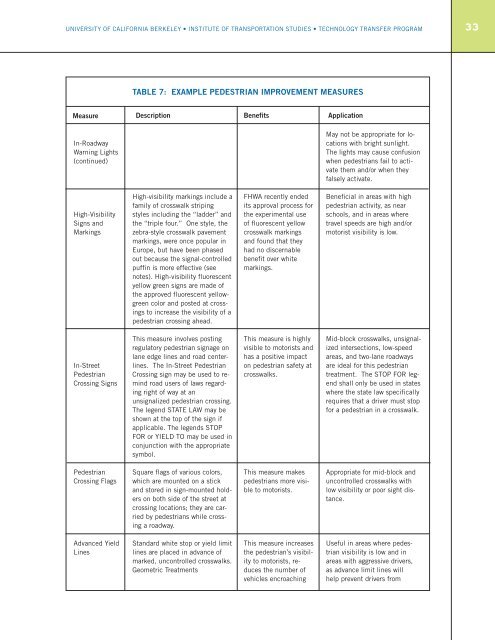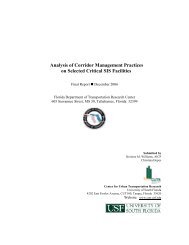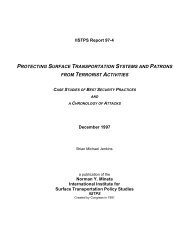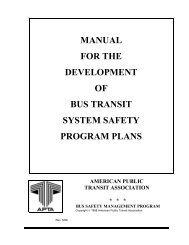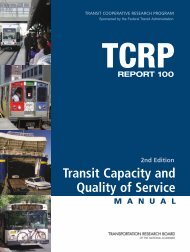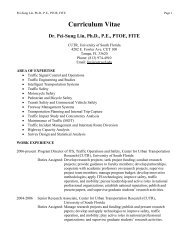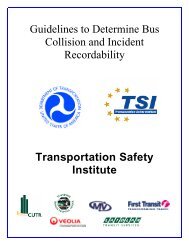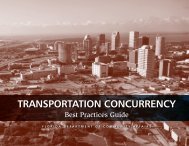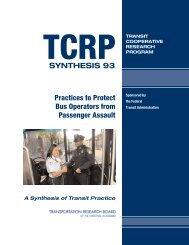a technical guide for conducting pedestrian safety assessments
a technical guide for conducting pedestrian safety assessments
a technical guide for conducting pedestrian safety assessments
You also want an ePaper? Increase the reach of your titles
YUMPU automatically turns print PDFs into web optimized ePapers that Google loves.
UNIVERSITY OF CALIFORNIA BERKELEY • INSTITUTE OF TRANSPORTATION STUDIES • TECHNOLOGY TRANSFER PROGRAM<br />
33<br />
TABLE 7: EXAMPLE PEDESTRIAN IMPROVEMENT MEASURES<br />
Measure Description Benefits Application<br />
In-Roadway<br />
Warning Lights<br />
(continued)<br />
May not be appropriate <strong>for</strong> locations<br />
with bright sunlight.<br />
The lights may cause confusion<br />
when <strong>pedestrian</strong>s fail to activate<br />
them and/or when they<br />
falsely activate.<br />
High-Visibility<br />
Signs and<br />
Markings<br />
High-visibility markings include a<br />
family of crosswalk striping<br />
styles including the “ladder” and<br />
the “triple four.” One style, the<br />
zebra-style crosswalk pavement<br />
markings, were once popular in<br />
Europe, but have been phased<br />
out because the signal-controlled<br />
puffin is more effective (see<br />
notes). High-visibility fluorescent<br />
yellow green signs are made of<br />
the approved fluorescent yellowgreen<br />
color and posted at crossings<br />
to increase the visibility of a<br />
<strong>pedestrian</strong> crossing ahead.<br />
FHWA recently ended<br />
its approval process <strong>for</strong><br />
the experimental use<br />
of fluorescent yellow<br />
crosswalk markings<br />
and found that they<br />
had no discernable<br />
benefit over white<br />
markings.<br />
Beneficial in areas with high<br />
<strong>pedestrian</strong> activity, as near<br />
schools, and in areas where<br />
travel speeds are high and/or<br />
motorist visibility is low.<br />
In-Street<br />
Pedestrian<br />
Crossing Signs<br />
This measure involves posting<br />
regulatory <strong>pedestrian</strong> signage on<br />
lane edge lines and road centerlines.<br />
The In-Street Pedestrian<br />
Crossing sign may be used to remind<br />
road users of laws regarding<br />
right of way at an<br />
unsignalized <strong>pedestrian</strong> crossing.<br />
The legend STATE LAW may be<br />
shown at the top of the sign if<br />
applicable. The legends STOP<br />
FOR or YIELD TO may be used in<br />
conjunction with the appropriate<br />
symbol.<br />
This measure is highly<br />
visible to motorists and<br />
has a positive impact<br />
on <strong>pedestrian</strong> <strong>safety</strong> at<br />
crosswalks.<br />
Mid-block crosswalks, unsignalized<br />
intersections, low-speed<br />
areas, and two-lane roadways<br />
are ideal <strong>for</strong> this <strong>pedestrian</strong><br />
treatment. The STOP FOR legend<br />
shall only be used in states<br />
where the state law specifically<br />
requires that a driver must stop<br />
<strong>for</strong> a <strong>pedestrian</strong> in a crosswalk.<br />
Pedestrian<br />
Crossing Flags<br />
Square flags of various colors,<br />
which are mounted on a stick<br />
and stored in sign-mounted holders<br />
on both side of the street at<br />
crossing locations; they are carried<br />
by <strong>pedestrian</strong>s while crossing<br />
a roadway.<br />
This measure makes<br />
<strong>pedestrian</strong>s more visible<br />
to motorists.<br />
Appropriate <strong>for</strong> mid-block and<br />
uncontrolled crosswalks with<br />
low visibility or poor sight distance.<br />
Advanced Yield<br />
Lines<br />
Standard white stop or yield limit<br />
lines are placed in advance of<br />
marked, uncontrolled crosswalks.<br />
Geometric Treatments<br />
This measure increases<br />
the <strong>pedestrian</strong>’s visibility<br />
to motorists, reduces<br />
the number of<br />
vehicles encroaching<br />
Useful in areas where <strong>pedestrian</strong><br />
visibility is low and in<br />
areas with aggressive drivers,<br />
as advance limit lines will<br />
help prevent drivers from


